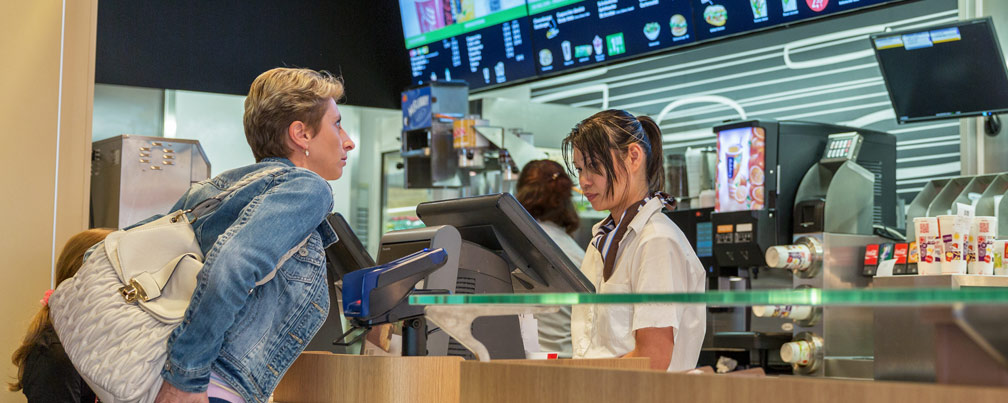Fast food
Over the course of the 20th century, several factors, such as urbanisation, industrialisation, more women entering the workforce and greater access to leisure activities, holidays and travel, led to a change in lifestyle. More people began eating meals outside the home and restaurant chains emerged, offering food prepared very quickly and presented with minimal table service.
The arrival of production lines in kitchens
The profound economic, urban and social changes of the 20th century resulted in people eating their meals more and more often outside the home. A new style of restaurant appeared, offering simple dishes that were prepared quickly and presented with minimal service, thereby changing people’s eating habits. This concept marked the beginning of fast food, and a whole new style of eating out. It emerged in the United States during the interwar period, a time when cars became more affordable. Hot dog stands sprang up along main roads, as did drive-in restaurants, where waitresses brought the food directly to customers’ cars.
In the late 1940s, to increase efficiency, the McDonald brothers developed a new, faster and cheaper method for preparing food. They removed two thirds of the meals from their menu, along with crockery and cutlery, keeping only hamburgers, cheeseburgers and chips served on cardboard plates. They used the same seasoning on all the hamburgers (ketchup, onions, mustard, gherkins), no longer requiring the skills of specialised chefs, and assigned a specific task to each employee. Finally, customers were no longer served at the table but queued to place their order. Once an order was placed, one employee was in charge of grilling the hamburgers, a second wrapped them, a third prepared the drinks, a fourth cooked the chips while a fifth took the customer’s payment.
For the first time ever, the principles of an industrial assembly line were applied to a restaurant kitchen. This system revolutionised the restaurant industry and was embraced by other fast food chains (KFC, Pizza Hut, Taco Bell, Burger King, etc.). The major chains secured the loyalty of their customers with huge advertising campaigns, special offers and sponsoring. Once successfully established in the United States, in the late 1950s, the major chains began to export the concept across the world.
Despite their success, fast food chains draw considerable criticism. Accusations focus on employees’ low wages, certain health problems possibly caused by the chains’ products, the use of GMOs (genetically modified organisms) and the environmental impact of meat production and packaging waste.
Adjustments to respect local customs and traditions
As fast food restaurants became established in Europe, they were seen as a modern and exotic American import, far removed from traditional restaurants, where the decor, tableware and service are just as important as the food. In developing countries, the exoticism of American-style fast food brought with it a certain social prestige at the expense of traditional, locally-produced, cheaper street food. While some people embrace fast food, others are not so keen on this new experience. Indeed, fast food not only offers new products, it also represents a new way of eating with a different culinary environment and different social interactions. Paying before eating and then having to clear the table oneself at the end of the meal is not always to everyone’s taste. Consequently, fast food outlets have had to adapt to local customs. For example, McDonald’s restaurants in Rio de Janeiro (Brazil), Caracas (Venezuela) and South Korea employ waiters. In terms of the menu, fast food restaurants in India do not serve beef or pork and offer more vegetarian menus to satisfy their Hindu and Muslim customers. Likewise, they serve kosher menus in Israel and in other countries with a considerable Jewish population, and halal menus in Muslim countries.
A vast choice of fast food
Nowadays, there are many different types of fast food. Each chain has its own speciality: Japanese, Chinese, Italian, Mexican or Oriental food, sandwiches, pizzas, fried chicken, hamburgers, bakery products, ice creams, coffee, tea etc. Most also offer desserts and a selection of drinks, while some also serve salads and soups as well as vegetarian menus.
DUBINSKY-TITZ, Monique, 2000. Fast food et exotisme. In : Révolution dans les cuisines. Revue des sciences sociales [en ligne]. N°27, pp. 81-85. [Consulté le 14 octobre 2016]. Disponible à l’adresse : http://www.revue-des-sciences-sociales.com/pdf/rss27 p.83
RÉMÉSY, Christian, 2005. Que mangerons-nous demain ? [en ligne]. Paris : Odile Jacob. [Consulté le 14 octobre 2016]. ISBN 9782738115775.
SCHLOSSER, Éric, 2003. Les empereurs du fast-food. Paris: Autrement.
SMITH, Andrew F., 2006. Encyclopedia of Junk Food and Fast Food [en ligne]. Westport : Greenwood. [Consulté le 14 octobre 2016]. ISBN 9780313335273. Disponible à l’adresse : https://www.academia.edu/5780572/ENCYCLOPEDIA_OF_JUNK_FOOD_AND_FAST_FOOD
SMITH, Andrew F., 2009. Eating History: 30 Turning Points in the Making of American Cuisine. [en ligne]. New York : Columbia University Press. [Consulté le 14 octobre 2016]. ISBN 9780231140935.
SMITH, Andrew F., 2016. Fast Food: The Good, the Bad and the Hungry [en ligne]. London : Reaktion Books. [Consulté le 14 octobre 2016]. ISBN 9781780235745.
WINARNO, F.G., ALLAIN, A., 1991. Street foods in developing countries: lessons from Asia. In: Food, Nutrition and Agriculture. [en ligne]. Rome: Food Agriculture Organization. [Consulté le 14 octobre 2016]. Disponible à l’adresse : http://www.fao.org/docrep/u3550t/u3550t08.htm#defining street foods and fast foods








